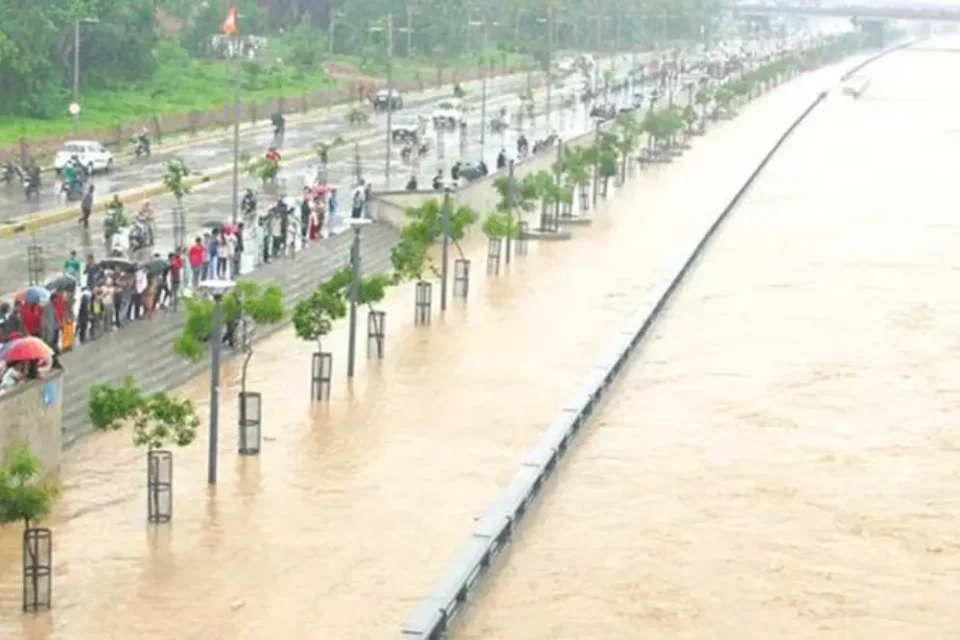Ahmedabad High Alert: Sabarmati River and Walkway Witness Flood Situation Like Never Before

The city of Ahmedabad has been placed on high alert as the Sabarmati River swells beyond danger levels, creating an unprecedented situation along its iconic riverfront walkway. Heavy rainfall in upstream regions and continuous water release from reservoirs have turned the serene river into a turbulent force, leading to safety concerns, disruptions in daily life, and widespread alerts for residents.
Sabarmati River Swells to Dangerous Levels
The Sabarmati River, which flows through the heart of Ahmedabad, has seen its water levels rise rapidly due to intense monsoon rains. Authorities have reported that water discharge from the Dharoi Dam and nearby catchment areas has significantly contributed to this sudden surge. The calm riverfront, which is usually bustling with morning walkers, families, and tourists, is now cordoned off with barricades, warning signs, and strict monitoring.
Officials from the Ahmedabad Municipal Corporation (AMC) have urged citizens to avoid visiting the riverfront area, citing risks of flash flooding, slippery pathways, and potential breaches along the embankment zones.
Flood-Like Situation Along Riverfront Walkway
For years, the Sabarmati Riverfront Development has been a symbol of urban planning and recreation. However, the heavy water inflow has transformed the elegant walkway into a flooded corridor. Water has begun to overflow onto pedestrian zones, drowning benches, light poles, and landscaped gardens that once offered peaceful leisure.
Eyewitnesses described the sight as “never seen before in recent decades”, with strong currents lashing against the protective walls. Drone visuals and local photographs have gone viral, showing submerged walkways and gushing water swirling dangerously close to public areas.
Impact on Daily Life in Ahmedabad
The high alert in Ahmedabad has led to several precautionary steps:
- Traffic diversions around low-lying areas near the river.
- Suspension of cultural events at the Sabarmati Riverfront.
- Closure of public access to gardens, pathways, and boating activities.
- Emergency shelters being prepared for residents living in riverside slums.
Residents along the low-lying riverbank settlements have been asked to evacuate immediately. Schools in certain flood-prone zones declared temporary holidays, ensuring safety for children. Daily commuters have also been affected, as waterlogging on connecting roads has slowed down traffic across the city.
Government and AMC’s Emergency Response
The Ahmedabad Municipal Corporation and the Gujarat State Disaster Management Authority are working in coordination to tackle the crisis. Rescue teams, fire brigade personnel, and National Disaster Response Force (NDRF) units have been deployed along critical points.
Real-time monitoring of the water level is being carried out through automated gauges and CCTV surveillance at strategic bridges. Control rooms have been set up across Ahmedabad to respond quickly to distress calls from citizens.
Officials also confirmed that dams upstream have opened their gates, which may cause further water release in the coming days. Citizens have been strictly instructed not to venture near the Sabarmati during this period.
Why This Flood Is Unprecedented
While Ahmedabad has faced monsoon floods before, experts believe the current scenario is more alarming due to a combination of factors:
- Excessive rainfall in northern Gujarat and Rajasthan catchment areas.
- Sudden dam water releases, leading to sharp surges in river levels.
- Urban expansion along floodplains, reducing natural water absorption capacity.
- Climate change contributing to unpredictable rain patterns.
Environmentalists have warned that while the Sabarmati Riverfront Project has beautified Ahmedabad, it has also reduced the natural floodplain buffer, making the city more vulnerable during extreme weather conditions.
Public Safety Measures Issued
Authorities have circulated detailed safety advisories for citizens:
- Stay away from riverfront zones until official clearance is given.
- Avoid crossing bridges during heavy rainfall and water surges.
- Keep emergency contact numbers handy.
- Relocate from low-lying riverside settlements immediately.
- Follow official updates from AMC and Disaster Management helplines.
Citizens have been asked to remain calm but vigilant, as the situation is being closely monitored.
Economic and Social Impact on Ahmedabad
The flood-like situation has disrupted not just daily life but also economic activities:
- Tourism hit: The Sabarmati Riverfront, a major attraction, has been shut down, affecting vendors, boat operators, and small businesses.
- Retail slowdown: Shops and markets in flood-affected zones have reported low footfall.
- Property concerns: Real estate along riverfront areas has faced scrutiny, with potential buyers worried about long-term flood risks.
- Healthcare pressure: Hospitals are on alert for waterborne diseases, which typically rise after flooding events.
Despite these challenges, community spirit in Ahmedabad remains strong, with volunteers and NGOs stepping in to provide food, water, and essentials to displaced families.
Historical Context of Sabarmati Floods
The Sabarmati River has a history of flash floods, with major incidents recorded in the 1970s and early 2000s. However, due to the riverfront development project, floods had been largely controlled in recent years. This sudden “never-before” flood scenario is a reminder that nature’s force cannot be entirely contained.
Experts have called for revisiting urban planning models, ensuring that ecological balance and flood management remain at the core of future city projects.
What Lies Ahead for Ahmedabad
As rainfall forecasts continue to show heavy downpours in the coming days, the high alert in Ahmedabad remains in place. The city’s resilience will be tested as it balances between safety, emergency responses, and long-term planning to prevent such crises in the future.
Civic bodies have assured that once water levels recede, immediate steps will be taken to restore the riverfront, clean up debris, and bring normalcy back for residents and tourists. But for now, the message is clear — safety first.